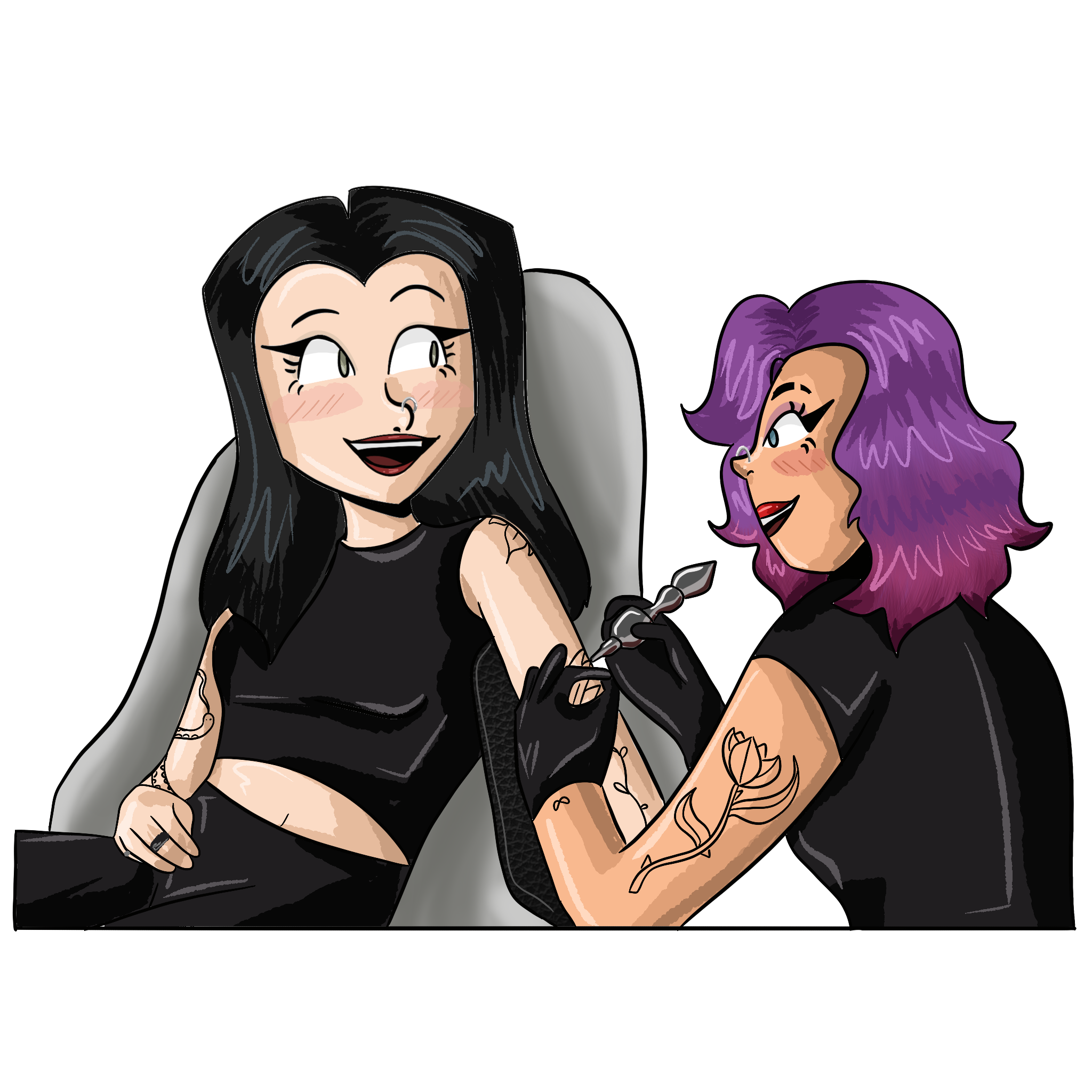What does it take to pick up a needle? How can a student find a tattoo artist they connect with? What does meaningful tattoo aftercare include?
These are all questions that an increasing number of university students are asking. A March 2024 Narrative Research study found a spike in tattoo interest across Canada, with 35 per cent of Gen Z now sporting ink.
For Syd Allen, a Concordia University art student and tattoo artist from Ottawa, building relationships is key to avoiding seeing student clients as a “canvas instead of a collaborator.”
With growing social acceptance of tattoos and expanding demographics of clientele, local artists are emphasizing the importance of maintaining a welcoming atmosphere for students from all backgrounds.
Artists reiterate the value in building human connections and not reducing clients to “blank canvases.”
Joining the force
In Ontario, becoming a tattoo artist isn’t the hassle one may expect.
There are regulations for tattoo parlours, but no specific licensing requirements, according to a statement from Ottawa Public Health.
“There is no requirement to be licensed to tattoo, however tattoo parlours are subject to the Ministry of Health’s Ontario Regulation 136/18: Personal Service Settings to prevent the spread of infections (e.g. blood-borne, fungal etc.),” the statement read.
Allen ventured into the tattoo realm knowing the challenges of affordability as a young person.
“I wanted tattoos but I couldn’t afford them and I knew how to draw so I was like … ‘I feel like I could figure this out,’” Allen said.
Starting out by gaining internet guidance and poking free designs on her close friends, Allen quickly transformed her dreams into an apprenticeship at Studio Citron Rose in Montreal.
When joining the studio, Allen received blood-health training.
“To tattoo, you’re supposed to have bloodborne pathogen training … a certificate that you get online that just certifies that you can deal with blood,” she said.
She has since discovered, however, that health implications are not the most common form of discomfort under the tattoo gun.
Personalizing experiences
Allen said that because customers may identify as part of different gender, sexual or cultural identities, there shouldn’t be a generalized strategy for approaching customers.
“I’ve heard a lot of horror stories from people I’ve tatted, and people in general,” she said. “They were just convinced to get a tattoo they didn’t really want or they weren’t comfortable speaking up to the artist.”
Allen said a desensitization as a tattoo artist to clients’ varying experiences can negatively impact the human experience of getting a tattoo.
“There isn’t one formula for interacting with people,” she said. “I make conversation. I don’t go right into business. When I meet someone for the first time, I’m not like ‘Okay, now get on the table,’ because I don’t think anyone would want that.”
Allen said people aren’t “pre-written,” meaning it’s important to nurture relationships prior to inking someone’s skin.

For Cas Davies, a first-year student at Carleton with an artistic edge, ensuring his creative voice was heard was important when he got his first tattoo in August.
“It was something I drew myself … It was something I had a personal connection with,” he said. “It was pretty straightforward. I went there, I signed the forms and she gave me the tattoo. It was great.”
Allen said a collaborative process should be honoured throughout the tattoo industry.
“Remember that it’s a person that you’re changing, like permanently,” Allen said. “I think a lot of artists, if they’ve been around for a long time, kind of lose sight of, ‘this is a person.’ They kind of see it as a canvas instead of a collaborator.”
She added this mindset can lead to lessening sincerity and the propagation of oppressive ignorance, creating an uncomfortable possessiveness over the artwork itself.
“[Artists] don’t remember that [the client is] the one living with the tattoo at the end of the day,” she said. “I do the tattoo and I hang out with them for a few hours, and then they leave and that tattoo stays with them. It’s not mine anymore.”
The safe space shift
Tattoo artists have also been approaching the concept of how their parlours can remain a welcoming space for every client.
According to Mariah Landers, owner of Ottawa-based Obscura Tattoo and a member of the tattoo industry for 23 years, a shift to safer spaces is needed.
“I’m not sure I can say I’ve ever felt like I belonged in any shop I’ve worked in,” she said. “While I have always felt a strong draw to the industry, I have typically felt like a bit of an outsider.”
In June 2020, on the first day tattoo shops were allowed to re-open in accordance with COVID-19 regulations, Landers opened Obscura Tattoo.
“I had so much experience to pull from,” Lander said. “As a queer, mixed woman I felt maybe my perspective could be valuable in creating a space people like me, be it clients or artists, could feel comfortable in.”
Landers said Obscura Tattoo’s creation was driven by her past experience observing concerning behaviours, languages and practices in the industry. At the time, she was working in parlours where she felt she lacked the authority to intervene.
“I saw opening my own studio as the way to possibly change all that, at least in my little corner,” she said.
During her training in Massachusetts, Landers picked up the “do onto others” motto for working with customers. At Obscura Tattoo, her values have not strayed from this motto.
“I want to remember every time I’ve felt intimidated, mocked or ignored by someone tattooing me, and be the absolute opposite,” she said.
Striving to create an environment in which “everyone can see a bit of themselves,” Landers said she aims for Obscura Tattoo to be based on an artist-forward business model with zero tolerance for inappropriate behaviour.

Artists and clientele alike, Landers said she aims to propagate a sense of belonging amongst all who come into contact with her and her parlour.
“When I’m hiring artists, I’m looking at not only the art, but their involvement in the community,” she said. “I’m looking for folks who recognize, if not have experienced firsthand, some of the ick that exists in the tattoo industry and maybe wanna change that with me.”
For Alex Creary, a software engineering student at Carleton, Obscura Tattoo “checked all the boxes” for her first tattoo experience. These boxes included working with a like-minded artist and specialization in the fine-line style she sought.
To anyone thinking about getting their first tattoo, Creary stressed the importance of prioritizing their values when searching for an artist.
“You don’t have to scope the place out beforehand […] but make sure that you like not only the work that they’re doing but also the person that they seem to be,” she said.
Creary said the consideration shown by her female Obscura Tattoo artist enriched her experience.
“In terms of where my tattoo was [on my body], I had expressed that I was nervous about it and she was like ‘Yeah, we’ll close the door.’ She gave me a towel or something as well just to put over my chest … so it wasn’t super revealing.”
Above all, Landers said tattooing is a personal experience.
“I think the most important thing I try to remember is my humanity,” she said.
When Landers interacts with her clients, she said she channels her own memories so she can enhance the one she is creating.
“I want to remember every time I’ve almost tapped out but felt revived by the kind words from an understanding artist,” she said.
When Emma Knynenburg, a Carleton technology student, embarked on acquiring her first tattoo, she said she was nervous about voicing her boundaries.
“I was really nervous and I’m not a confrontational person, so I was scared about them being harsh if they put the placement on me and I didn’t like it,” she said.
After connecting with a female tattoo artist at Obscura Tattoo, she said her fears began to ease.
Prior to arriving at the parlour, Knynenburg messaged with her artist about what the process would entail. When they met in person, she said the connection only deepened.
“As she was tattooing me, she kinda felt what I wanted,” she said. “If I was in a chatty mood, she’d chat back but if I was in pain or not looking to chat, she wouldn’t. She wouldn’t push for anything.”
Now a few tattoos wiser, Knynenburg said her ideal parlour interaction includes a few key elements.
“I just want the artist to be an open and communicative person,” she said. “Obviously it’s their work and they should be proud of it, but if it’s not something you are completely in love with, they should be OK to change it since it’s going on your body.”
Landers emphasized the overall importance of stewarding thoughtful spaces that treat people as more than blank canvases.
“Hopefully, when I’m thinking of those moments, I’m able to be a better steward for the art I put on other people’s bodies.”
Featured graphic by Alisha Velji/the Charlatan.






